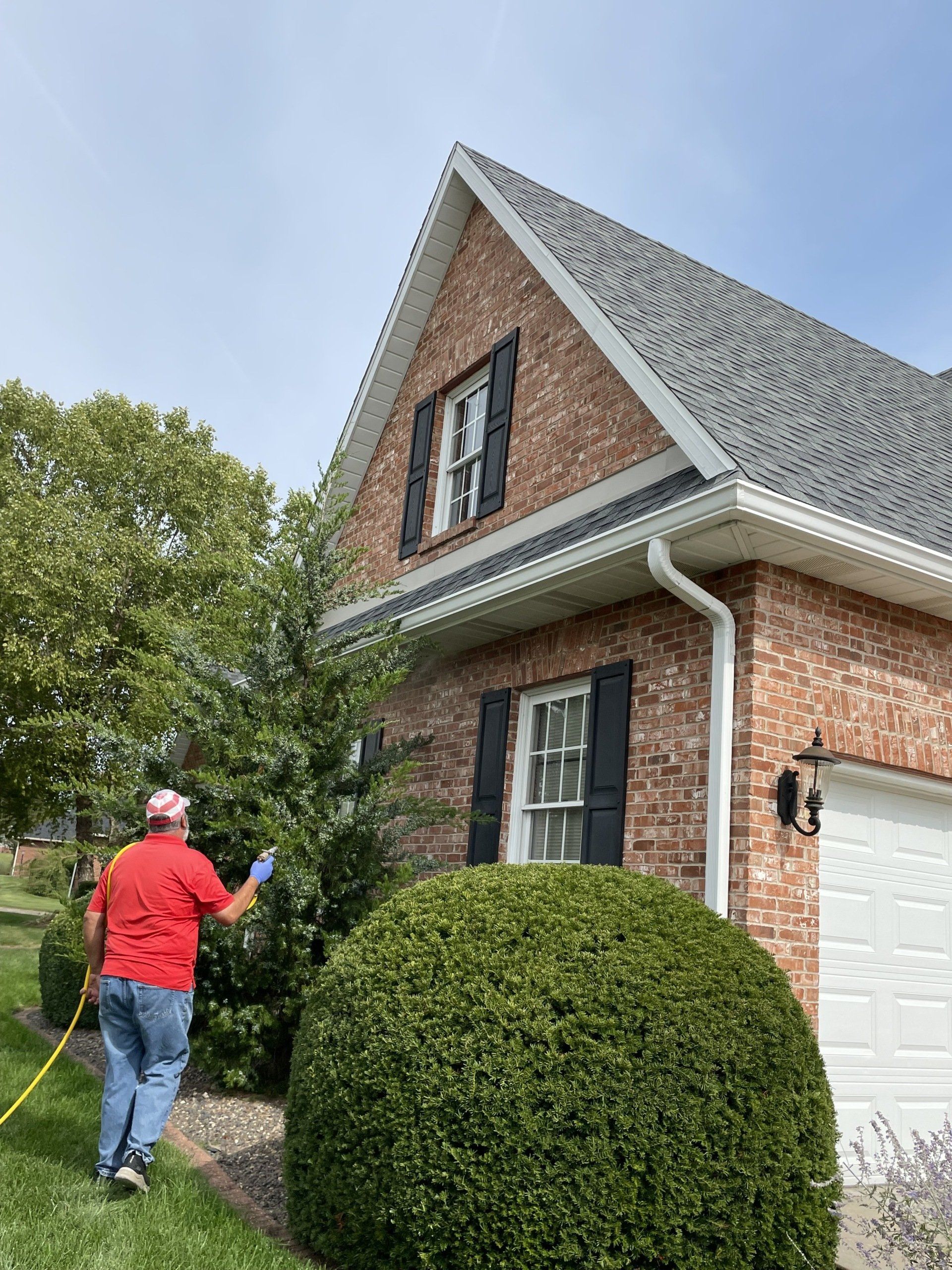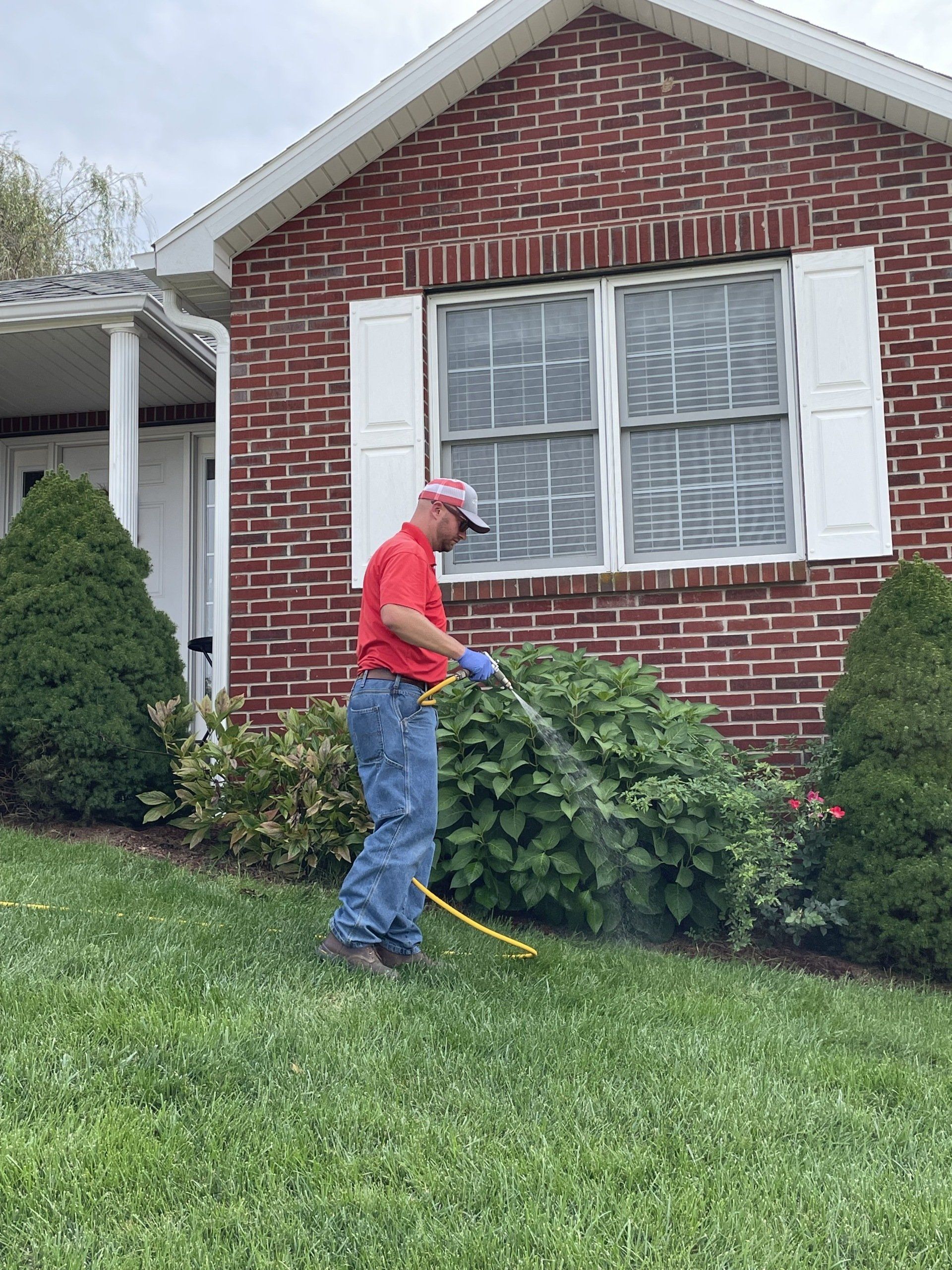Common Pests Library
Learn the type of pests that live on your property. Art’s Pest Control helps eliminate insects and mice in homes and businesses throughout the Jefferson, MO area. Licensed and insured, we have battled pests since 1986. Let us help you protect your property.
You’ll find below pictures and descriptions of common pests found in our area.

Acrobat Ants
Acrobat ants are very small, about 5.4 millimeters in length. Often they are found nesting behind siding, under rocks or landscaping, near leaking roofs and stumps or wood piles. Acrobat ants also like to nest in damaged wood or galleries made by other insects. They like to eat sweets and meat, also known to emit an unpleasant odor when disturbed.
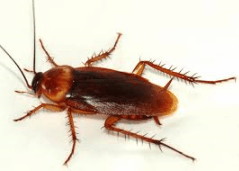
American Cockroach
The American cockroach is the largest of the house-infesting cockroaches. Despite its name, the American cockroach is not native to North America, but was probably introduced via ships from Africa in the 1600s. American cockroaches often enter structures through drains and pipes. They are more active when the temperature is 70 degrees or higher, but they can survive lower temperatures with the right conditions. Although American cockroaches can be found in homes, they are also common in larger commercial buildings such as grocery stores, food processing plants and hospitals. American roaches are also known to infest basements, yards, and alleys.
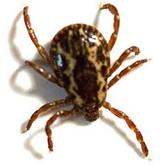
American Dog Tick
The American dog tick gets its name from the fact that adult ticks prefer domestic dogs as hosts, and this tick species is only found in North America. It is thought that American dog ticks are attracted by the scent of animals, so they are common along roads and trails. Adult ticks prefer domestic dogs as hosts and can therefore be brought into the home and potentially transferred to humans. These ticks prefer grassy areas with low vegetation where larger mammals pass by. American dog ticks do not survive well indoors. The American dog tick is the primary vector of Rocky Mountain spotted fever in the United States.
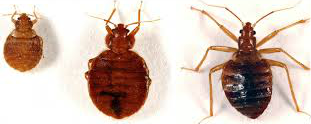
Bed Bugs
Bed bugs typically are active at night and hide during the daytime. Being very flat, they are able to find a wide variety of places in which to hide. Typical hiding places include beneath loose flooring, behind loose wallpaper, inside box springs, in mattresses, and in upholstered furniture. One common hiding place in hotel rooms is behind bed headboards that are fastened to the wall and another is behind moldings just above the floor. Bed bugs also hide behind electric switch plates and inside appliances. However, sites that have surfaces consisting of plaster, stone, and metal typically do not harbor bed bugs. Bed bugs feed on warm-blooded animals. They have a normal host with which they live and on which they feed, but they will feed on other species. For example, bed bug larvae and adults feed readily on humans, bats, and chickens, and they do so when the host is at rest. Thus, bed bugs living with humans typically feed at night while a person sleeps, but they also will feed during the day in dark structures such as infested theaters with upholstered seats. Male and female adults usually feed every 3-4 days and become engorged with blood in about 10-15 minutes. Bed bugs detect carbon dioxide emitted from warm-blooded animals and respond to warmth and moisture as they approach the potential host. On humans, they tend to feed on exposed surfaces such as the face, neck, arms, and hands. Again, the bites are painless, and the host typically is not disturbed while bed bugs feed.
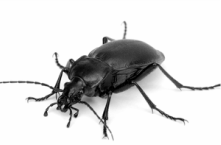
Black Ground Beetle
Common Black Ground Beetles are typically shiny black in color and have an elongated – somewhat flattened body. Ground beetles are typically found on the ground and will harbor beneath stones, concrete slabs, wood piles and other similar ground coverings during the daytime. Ground beetles can enter structures by crawling under door openings or will fly through open doors and windows. Common Black Ground Beetles breed in late Summer. The female lays eggs just below the soil surface. Larvae hatch and spend the winter in the soil. In early spring the larvae begin feeding and then turn into pupae. They come out as adult beetles in the Summer. Some adults overwinter as well.
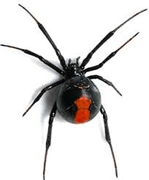
Black Widow Spider
Black widow spiders are most recognized for the red hourglass shape under their abdomen. Black widows are poisonous when ingested during the first 17 days of their life. Black widows are active when the temperature is 70 degrees or higher, but they can survive lower temperatures with the right conditions. Black widow spiders spin irregular webs, which they build at night near ground level. Once complete these spiders hang upside-down in their webs. Outdoors, black widow spiders commonly live in protected areas like under stones and in firewood piles. They are often found in barns, outhouses, and sheds. Indoors, black widows prefer cluttered areas of garages, basements, and crawl spaces. While male black widow spiders rarely bite, females are known to be aggressive and bite in defense, especially after laying, and when guarding eggs.

Box Elder Bug
Box elder bugs are black winged insects with 3 red stripes running lengthwise down the body. The underneath of their wings is bright red. Immature box elder bugs or nymphs are wingless, smaller and rounder shaped, and bright red in color. Box elder bugs are found on elm, maple and box elder trees. They are found on houses and structures usually on the sound side during warm days where the sun is shining.
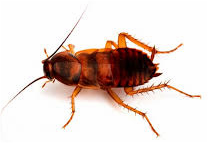
Brown Banded Cockroach
Brown-banded cockroaches get their name from the two lighter bands they have across their dark brownish bodies. Male, brown-banded roaches have full wings that reach beyond the tip of their pointed abdomens, but females have underdeveloped wings that prohibit them from flying. Brown-banded cockroach can be found throughout structures but show a preference for drier locations and warmer areas over 80 degrees. Brown-banded cockroaches often hid their egg cases in or under furniture. These roaches tend to prefer higher locations than most cockroach species and are often found in upper cabinets in kitchens and bathrooms.
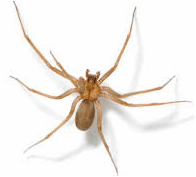
Brown Recluse Spider
Brown recluse spiders have a characteristic dark brown violin marking on their back. Brown recluse spiders are nocturnal and eat other small bugs like cockroaches and crickets. These spiders spin irregular webs, which are not used for catching prey but rather as a retreat. Brown recluse spiders often live outdoors where they are typically found around rocks, utility boxes and woodpiles. Indoors, brown recluses can be found in any undisturbed area, such as inside boxes, among papers, in seldom-used apparel and shoes, under furniture or in crevices of window moldings. Closets, attics, crawl spaces and basements are the most common brown recluse spider hiding spots. Like the black widow spider, the brown recluse spider bites in defense and does not bite humans instinctively. However, both female and male brown recluse spiders can bite and inject venom. The brown recluse’s bite is usually not felt but results in a stinging sensation followed by intense pain as long as six to eight hours later. A small blister usually develops at the bite location that can turn into an open ulcer.
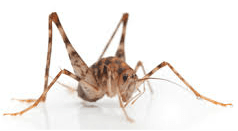
Camel Cricket
Camel crickets get their common name from their humpbacked appearance, which is similar to that of a camel. They are widespread in the United States and in the world. Camel crickets do no possess sound producing organs, and therefore do not chirp. The adult camel crickets do not have wing, unlike other cricket species. Camel crickets leap when they are frightened since it's the only defense mechanism they have to scare off predators. Camel crickets are nocturnal, or active at night, and hide during the day. They often overwinter as young nymphs or adults. Females lay their eggs in early spring and they hatch during April. Camel crickets are found outdoors around buildings, typically in cool, moist environments such as under mulch, stones, railroad ties, woodpiles and debris. Around homes they can also be found in wells and drainage pipes, or under sheds and air conditioners units. Indoors, camel crickets are often found in damp basements, utility rooms, crawl spaces, garages and occasionally in attics. They often invade structures when it becomes hot and dry outside.
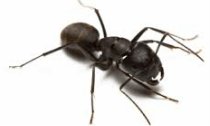
Carpenter Ant
Carpenter ants are the largest ants (6 to 10mm) and often are black, red or dark brown. The most distinctive habit of the carpenter ants is their ability to nest in wood. Galleries are excavated and the ants pile coarse sawdust at the nest openings. Unlike termites that eat wood, carpenter ants scavenge on dead insects, insect honeydew or other materials. Carpenter ants primarily nest in wood that is softened by water damage and decay. Nests that are made from damaged wood can result in further structural damage. Carpenter ants do not sting but can produce a mildly painful pinch from their jaws.

Centipede
Centipedes are sometimes called "hundred-leggers" because of their many pairs of legs, but they can actually have anywhere from 15-177 pairs of legs, depending on the species. Interestingly, centipedes always have an odd number of pairs of legs. Most house centipedes are nocturnal, and prey primarily on flies, spiders, and sometimes plant tissue. Centipedes are typically found in areas of high moisture, such as in rotting logs, under stones, in trash or piles of leaves/grass. When they invade homes, centipedes are most commonly found in damp basements, crawlspaces, bathrooms, or potted plants.
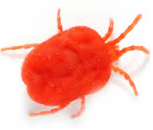
Chigger
A Chigger is often seen in lawns and moving across pavement. They are brilliant red and are often called "red bugs". In Missouri the adult stage spends its winter in the soil and the females will deposit eggs during the first warm days of spring. Eggs hatch into chiggers that are only about 1/150 inch in diameter. The threat of being attacked exists from May until the first killing frost. After coming into contact with a human host, chiggers will crawl upward, going under or through clothing until they find an area where clothing fits tightly against the skin. Rather than pass through tight places, they will frequently settle down and begin to feed. They commonly feed in areas such as the tops of shoes and socks, inside tight-fitting underwear, under a waistband or bra band, at the back of the knees. It can take several hours after being bitten to have a reaction to chiggers.
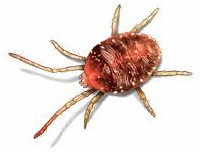
Clover Mite
Clover mites are reddish brown in color and ovoid in shape. As arachnids, mites have found pairs of legs and are incapable of flight. Clover mites are slow moving. They are known to reproduce in the spring and summer when temperatures are suitable for their breeding and survival. Their populations grow rapidly, as females lay up to 70 eggs, each of which matures within 30 days. Eggs can be found in small crevices in concrete and wooden structures, as well as within walls, under loose bark and in other protected locations. Clover mites feed on plants, with clover being a preferred food source, hence their name. When plants begin to die in the fall, it results in the mass movements of the mites, potentially into the home.
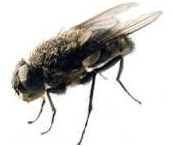
Cluster Flies
Adult Cluster flies are 3/8 inch long, robust, and colored dark gray with numerous short golden hairs on the thorax and with irregular lighter areas on the abdomen. The wing tips overlap at rest. Overwinter cluster flies are typified by sluggish movements indoors. Adult cluster flies overwinter in sheltered places, emerging in the spring to mate. Eggs are laid in soil cracks and hatch in about 3 days. As days shorten and the weather cools (in September and early October), cluster flies often enter structures to overwinter, sometimes traveling more than a mile to do so. They usually occupy attics and wall voids of the sun-warmed south, east, and west exposures of houses and buildings.

Common House Spider
The Common house spider is usually the spider most often encountered indoors. It is a nuisance pest, probably more because of its webs than the spider itself. The house spider is found worldwide and is common throughout the United States and Canada. The house spider randomly selects its web locations and creates a tangled web. If a web does not yield prey it is abandoned, another site is selected, and a new web is built. House spiders have a difficult time surviving in modern homes due to low humidity and fewer insects for food. They are more likely to prosper inside structures like garages, sheds, barns, and warehouses. Outside these domestic spiders are often around windows and under eaves, especially near light sources that attract prey.
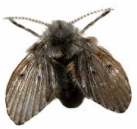
Drain Flies
Drain flies measure about 1.5 to 5 mm long with a light gray or tan body and lighter-colored wings. The body and the wings are covered with long hairs, giving the fly a fuzzy appearance. When at rest, the drain fly folds its wings over the body in a characteristic roof-like manner. In homes adults are found in bathroom, kitchen, or basement walls. More active at night, drain flies do not bite or transmit human diseases. Drain flies feed on organic matter and sewage. Typically drain flies are seen resting on the walls in the bathrooms or near the breeding materials.

Field Cricket
Field crickets are usually black in color but can also be brownish yellow to yellow. They tend to live outdoors around woodpiles, under mulch, plant beds, and other moist environments. Their presence is often detected by the males loud chirping, which can be heard during both day and night. The field cricket can cause extensive damage to crops such as alfalfa, beans, oats, rye, tomatoes, wheat, etc. Besides crops, they also feed on other insects and crickets.
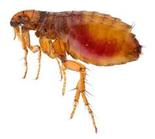
Flea
Fleas are reddish-brown in color, usually between 1-3 millimeters in length. They do not have wings; however they are able to jump a distance up to 13 inches. Fleas feed on blood, larvae typically feed on the excrement of adult fleas. These insects can carry diseases and have proven to be a significant nuisance to humans and animals alike. Most flea infestations occur through animals bringing them into the home. The flea will attach itself to an animal and lay eggs that usually end up being distributed throughout the home. Many times, the eggs become embedded in carpet flooring making it increasingly difficult to remove them before they hatch.
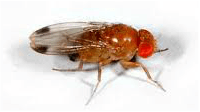
Fruit Fly
The Fruit fly is easily identified by its red eyes. Fruit flies are small pests that are commonly found in homes, restaurants, and other facilities where food is processed. They are found on moist, decaying matter that has been stationery for several days. Fruit flies are found in unsanitary conditions, so they are a potential health concern, especially when present in health facilities.
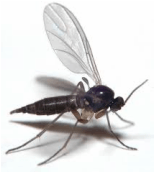
Fungus Gnat
Fungus gnats are pests of greenhouses, nurseries, and interior plantscapes. Adult flies are short-lived insects and may be noticed away from their breeding sources flying around light fixtures or windows. Outdoors, the problem spots are likely landscaped and/or heavily mulched areas or low-lying areas in the yard that remain extremely wet following heavy rainfall or a leaking outdoor water spigot. Indoor sources can be potted plants or fresh flowers with excessive moisture, kitchen or bathroom sinks/drains, damp crawlspaces,
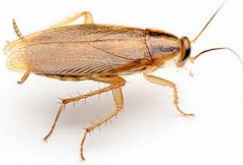
German Cockroach
The German cockroach is the most common species of the cockroach. German cockroaches can breed at a rate of up to six generations per year. The German cockroach can fit through an opening as small as 3/8 inch in width. German cockroaches will feed almost anything, including soap, glue, and toothpaste. German cockroaches are good hitchhikers and often find their way into new structures via grocery bags, cardboard boxes, drink cartons and secondhand appliances. German cockroaches prefer to live in warm, humid places close to food and moisture sources. They are frequently found in residential and commercial kitchen environments, and bathrooms. It is possible for the German cockroach to travel outdoors and from house to house in the summer months.
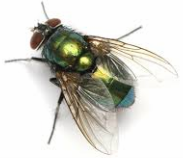
Green Blow Fly
Green Blow flies are partly metallic blue, green, or dull brassy, sometimes black. These flies are just as bad if not worse about transmitting diseases compared to the house fly. Blow flies live and breed in dead rotting flesh, if not available, they feed on animal excrement, decaying vegetation or garbage. Dead mice/rodents, birds or any other small animals can cause an infestation of Blow flies inside homes and structures. They are always the first one on the scene when an animal or human die. A lot of times the Blow fly larvae are used in forensics to determine time of death in a murder case.
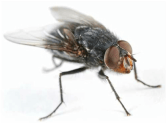
House Fly
House flies get their name from being the most common fly found around homes. Adult house flies can grow to one-quarter of an inch long and usually live between and days. They are only able to feed on liquids but have the ability to turn many solid foods into a liquid for them to eat. House flies taste with their feet, which are 10 million times more sensitive to sugar than the human tongue. House flies tend to stay within - miles of where they were born; however, they have been known to migrate up to miles to find food. These insects have been known to carry over 100 different kinds of disease-causing germs, which makes them very bad house guests.
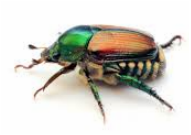
Japanese Beetle
Adult Japanese beetles can be easily identified by their coloring. The Japanese beetle has a metallic green body with copper-brown wing covers. Adults appear from the ground and begin feeding on plants in the early summer. The peak of their activity lasts from late June through August or September when they will begin to die off due to temperature and climate. Japanese beetles live for up to two months during their adult life form. Japanese beetles are commonly known to cause a multitude of damage to a variety of plants including vegetable crops, flowering plants and ornamental shrubs as rose bushes. They are attracted to the leaves produced by these types of plants. The beetles are most active on warm, sunny days, and prefer plants that are in direct sunlight.
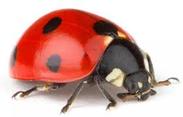
Ladybug
Ladybugs are also known as lady beetles or ladybird beetles. Most species of this beetle family are highly beneficial insects, but some have a habit of overwintering in structures leading them to become nuisance pests. During the spring and summer months, ladybug populations typically grow because the seasons favor tender foliage and aphid infestations. In the autumn, adults seek protected places to overwinter including under leaves, rocks, and landscape timers. Other ladybug species are known to inhabit structures such as buildings and homes.
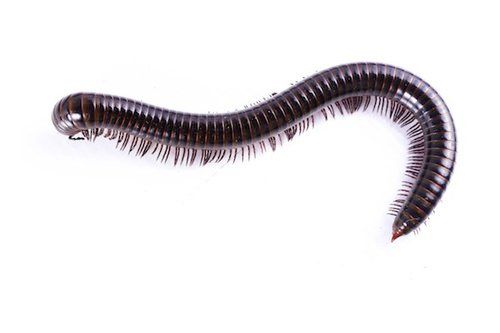
Millipede
Millipedes are often called "thousand-leggers" because of their many pairs of legs, but they can actually have anywhere from 30-90 plus pairs of legs, depending on the species. Most millipedes are nocturnal and are primarily scavengers, feeding on decaying plants and occasionally dead insects. In the autumn, millipedes are known to migrate in great numbers. Millipedes usually do not survive indoors for more than a few days unless there are high moisture conditions and a food supply is present.
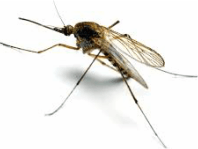
Mosquito
Mosquitoes are one of the best-known summer pests, they breed in stagnant water or soft soil. There are about 170 different kinds of mosquito species in North America alone. Mosquitoes hunt for food by detecting body heat and the carbon dioxide human’s exhale. However, only female mosquitoes suck our blood. Male mosquitoes feed on plant nectars. Mosquitoes are vectors of numerous diseases including malaria, yellow fever, dengue fever, encephalitis and West Nile virus - a disease that has become a serious concern in the U.S. in recent years.
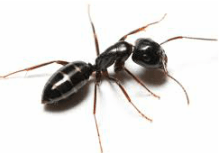
Odorous House Ant
The Odorous house ant gets its name from the strong, rotten coconut-like smell it gives off when crushed. These tiny brown ants range in size from one-sixteenth of an inch to one-eight of an inch long. Odorous house ants like sweets and are especially fond of honeydew. They are known to move their nests every three months or so in response to rain. Indoors, odorous house ants nest near moisture sources, such as in wall voids near hot water pipes, in heaters, beneath leaky fixtures and inside wood damaged by termites. Outside, they are often found in exposed soil or under stacks of firewood.
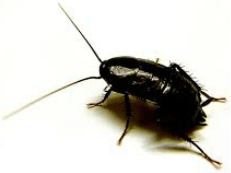
Oriental Cockroach
Despite their name, Oriental cockroaches are sometimes called "water bugs" because they come out of drains. The Oriental cockroach feeds on all kinds of food, especially decaying organic matter and starchy foods. This species of cockroach can live outdoors in freezing temperatures for long periods of time. Outside, Oriental cockroaches are often found in sewers and under debris, leaves, stones, and firewood. They will enter structures though door thresholds, under sliding glass doors, along utility pipes and through floor drains. Once indoors, Oriental cockroaches find harborage in basements and crawl spaces.
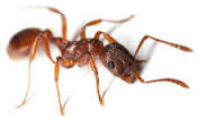
Pavement Ant
Pavement ants get their name because they make nests in or under cracks in pavement. These dark brown to black ants can also infest structures. These black ants will eat almost anything. Pavement ants have been known to consume insects, seeds, honeydew, honey, bread, meats, nuts, and cheese. They forage in trails for distances of up to 30 fee and are known to climb masonry walls that enter into occupied areas.
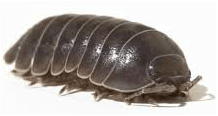
Pill Bug
The Pill bug is the only crustacean that has become completely adapted to spending its life on land. Pill bugs have oval bodies and seven pairs of legs. They are easily recognized by their back, which is made up of seven hard individual plates. Pill bugs are sometimes referred to as rollie-pollies. Pill bugs eat decaying vegetable material and are most active at night. They are known for their ability to roll into a ball. Pill bugs live in moist locations. They are found under damp objects or under vegetable debris.
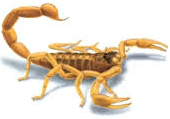
Scorpion
Scorpions are nuisance pests that are closely related to spiders, mites, and ticks. There are about 1,200 scorpion species in the world and 70 species in the United States. Scorpions are nocturnal pests, so they hide during the day and are most active at night. They feed primarily on insects, especially crickets and cockroaches, and they also feed on spiders. However, they can survive for months without food if water is readily available. During periods of hot weather, scorpions may enter homes through wall voids and take shelter in cool, moist areas like crawl spaces and attics.
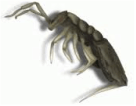
Springtail
Springtails are very small, jumping insects that sometimes alarm homeowners by appearing in large numbers in moist indoor areas such as kitchen sinks, bathtubs, and in the soil of houseplants. They may also be found outdoors in swimming pools, moist landscaped areas, or vegetable gardens, and on the surface of mud puddles. They usually appear in the spring and early summer but can be found year-round in moist environments. Because they jump when disturbed, springtails are sometimes confused with leas. However, springtails do not bite humans or pets, nor do they spread diseases or damage household furnishings.


